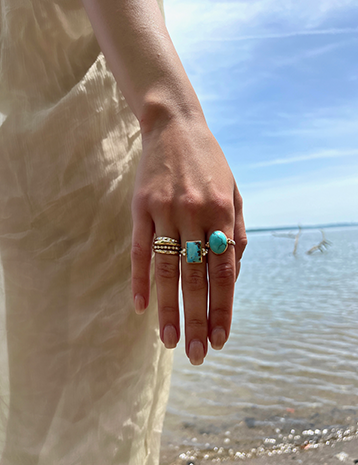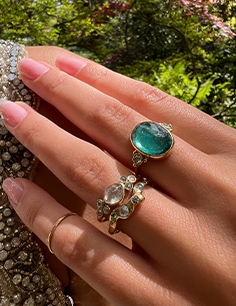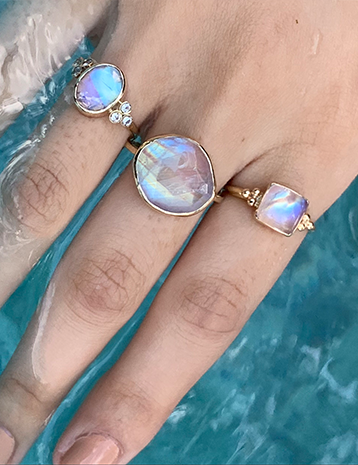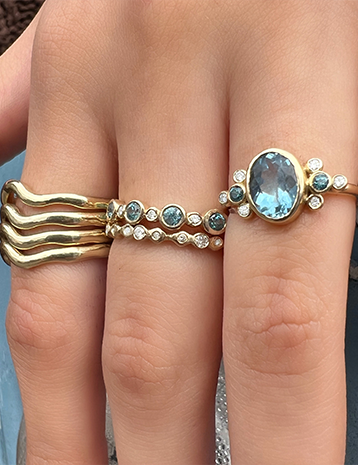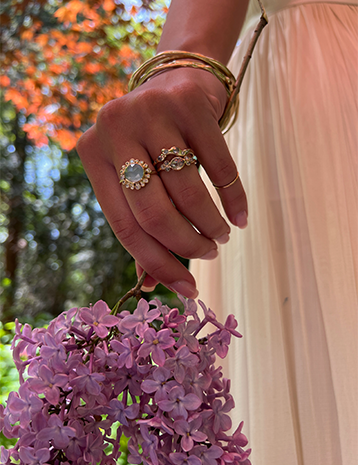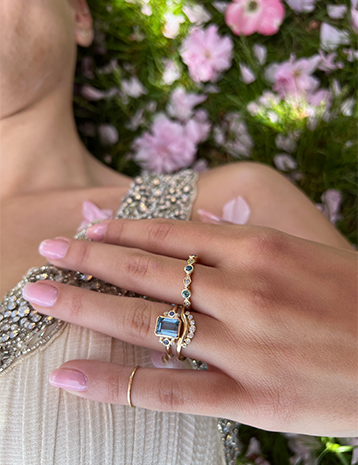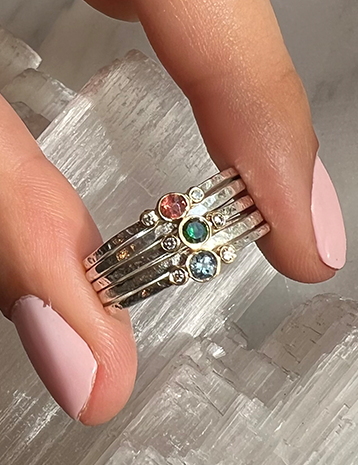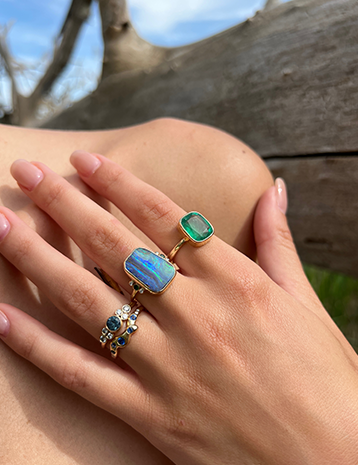Opal Jewelry: A Guide to Buying, Maintaining, and Enjoying This Gemstone

Opals are our absolute favorite stones! They're all so unique and different, and contain multitudes. Each one completely unique in their coloring and pattern. We love Australian Opals the most and we source most from small family mining operations who specialize in Lightning Ridge, Coober Pedy, Quilpie, and Andamooka, in Queensland.
If you’re unfamiliar with fine opal jewelry and are interested in getting your hands on this fantastic stone, you likely have questions. What is an opal? What do opals symbolize? What do they look like? What features of an opal impact its value?
Fine opal jewelry provides a distinctive look and feel with its unique shapes, colors, and patterns. Unlike many other types of gemstones, no two opals are alike. Therefore, finding the perfect opal for your personality can be a quest all on its own. Fortunately, we’re here to help you learn how to find, maintain, and enjoy the perfect handmade opal jewelry.
What is an Opal?
Opals are hydrated amorphous forms of silica that naturally occur in the fissures of limonite, sandstone, basalt, marl, and rhyolite. The water content within opals generally ranges between six and ten percent of the gemstone by weight.
Historically, fine opal jewelry was commonly associated with royalty and good luck. While wearing opals as jewelry is a modern practice, people wore these stones for various reasons in ancient times. For example, many believed that opals provided medicinal benefits to the eyes, so they were used to cure eye diseases. Other superstitions included the belief that opals could make the wearer invisible and aided in astral projection forms.
Today, natural opals are most commonly supplied from Australia. In fact, Australian opals make up about 95 percent of the world’s supply of opals.
How is the Value of Handmade Opal Jewelry Determined?
Opal values vary based on several factors, including:
-
Body color and tone: The color and tone of opals significantly impact their beauty and value. Generally, opals with darker tones have a greater value. This is because the darker the tone, the more prominent and vivid the opal’s color patterns appear. For example, black opals generally cost far more than white opals.
-
Brightness: The brighter the opal, the more profound its colors. Opal brightness is gauged by the amount of its reflected color when under a light. The brighter the opal, the more eye-catching it tends to be, and the higher the value. Fine opal jewelry that appears milkier and lacks a significant shine tends to be less valuable.
- Patterns and dead spots: Each opal has a distinctive look. Opals can contain a variety of colors and patterns. The larger the patterns of handmade opal jewelry, the greater its value. However, it is essential to look out for dead spots when shopping for opal jewelry. Opals can have sections that appear dull and static compared to the rest of the gem. These sections are referred to as dead spots, and they can devalue an opal.
Common Types of Fine Opal Jewelry
Many types of opals are commonly used in jewelry, including:
-
Black opals: These are darker-toned gems that have bright, vibrant colors. Black opals generally contain dark blue or black backgrounds and are typically the most valuable.
-
White opals: These are popular in the United States. They are generally milky white, pale yellow, or gray and are commonly translucent. The most valuable fine white opal jewelry has distinctive, even color patterns.
-
Crystal opals: These are semi-transparent to transparent and are considered the second most valuable type of opal.
-
Boulder opals: These are hardier than other types of opals as they are still attached to their sandstone or ironstone. This material gives it a darker background to increase the visibility of the opal’s colors while providing more durable jewelry.
-
Jelly opals: These tend to resemble moonstones as they lack the traditional bright colors. Handmade opal jewelry that uses jelly opals is generally more affordable.
- Fire opals: These contain yellow, red, or orange backgrounds, hence the name. Unlike some of the other types of opals, fire opals do not have milkiness or uniform color.
Caring for Your Fine Opal Jewelry
Like all jewelry, fine opal jewelry must be taken care of to retain its shine and prevent breakage. Opals, in particular, are considered fragile as they only hold a 5.5 to 6.5 hardness rating on the Mohs Hardness Scale. Even the highest quality opals are prone to scratches, so you must know how to care for your opal jewelry.
Opals should only be cleaned using warm water and mild soap. Pieces should never be left submerged in water as prolonged exposure can ruin them. Avoid scrubbing at the opal and avoid any abrasive surfaces.
Avoid wearing your jewelry when you are showering, swimming, sleeping, or sweating. Finally, keep your opal jewelry out of prolonged direct sunlight, as this can change the opal's color, shine, and durability. Remember, proper care and maintenance will ensure your handmade opal jewelry lasts a lifetime.
The Bottom Line
Each piece of fine opal jewelry has a distinctive and unique look. Now that you know more about these popular gemstones, you will be able to find the best handmade opal jewelry to suit your unique personality.
Are you looking for beautifully crafted, handmade opal jewelry? Take a look at our collection to find handmade opal rings, necklaces, and more.


